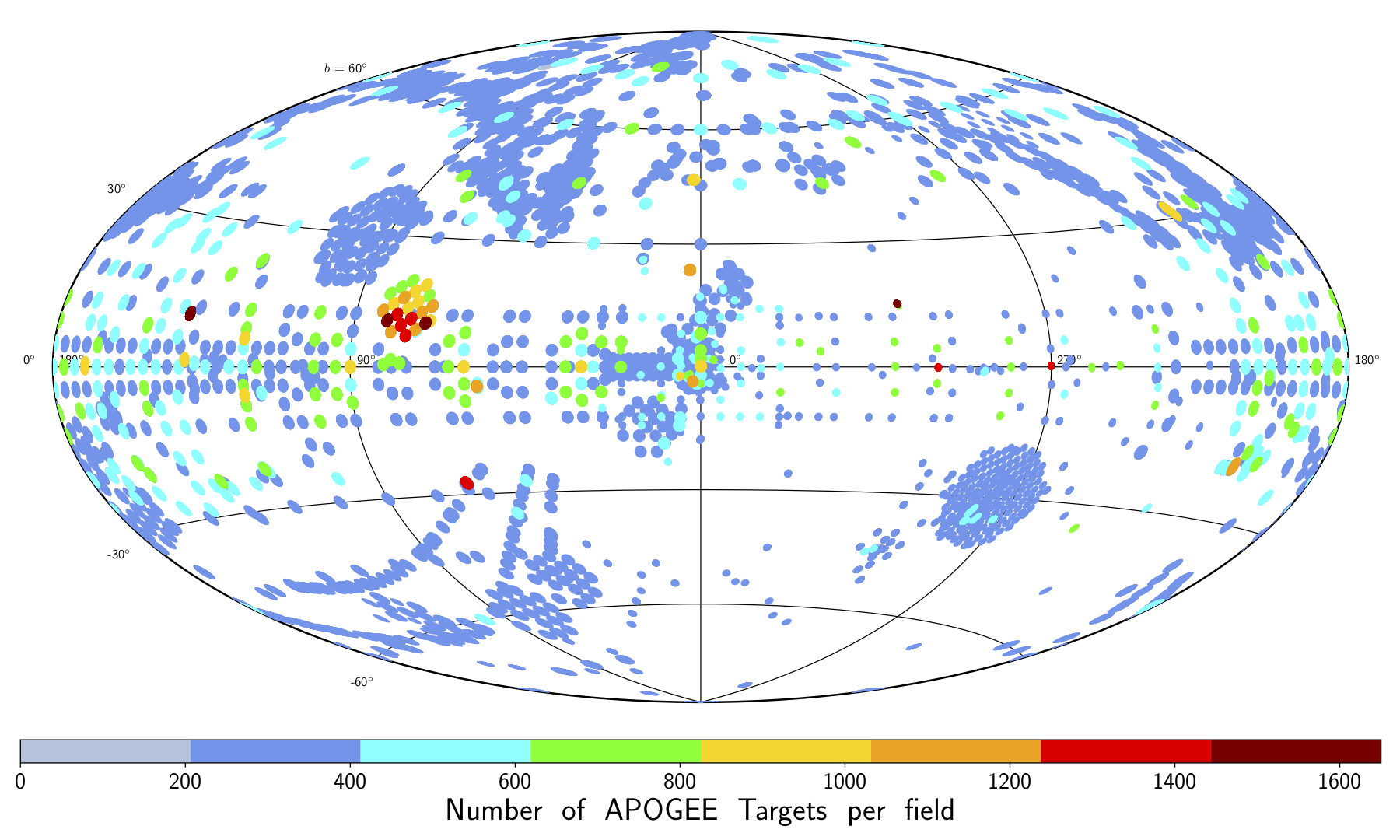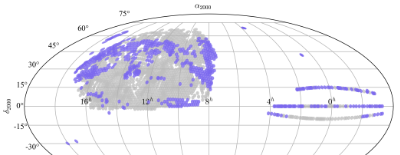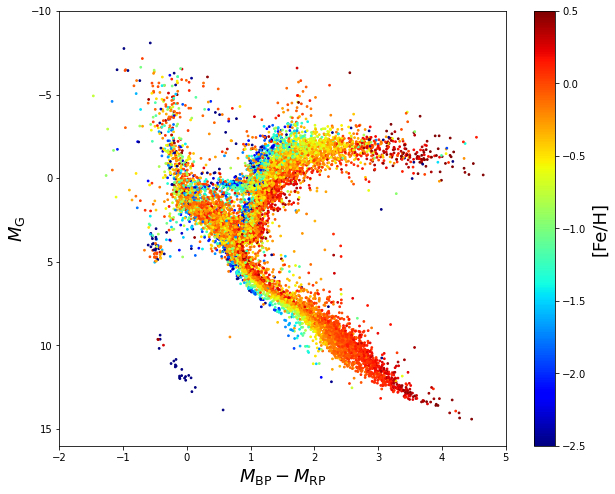What’s New in DR17
Data Release 17 (DR17) is the final data release of the Sloan Digital Sky Survey IV.
DR17 contains new optical and infrared spectra from both Apache Point Observatory and Las Campanas Observatory. Previously released integral-field datacubes and maps, stellar library spectra, as well as images, are also included in DR17.
APOGEE-2 is a large-scale survey of Milky Way stellar chemistry and kinematics. High-resolution infrared (H-band) spectroscopy allows APOGEE-2 to peer through interstellar dust extinction to provide a large, uniform database of precision stellar measurements throughout the Galaxy, spanning from the central bulge, through the disk and into the halo. APOGEE-2 operates in both the Northern and Southern hemispheres using near-twin spectrographs.
In DR17, APOGEE-2 releases an additional 2 years of observations from both Apache Point and Las Campanas Observatories. All observations taken with the APOGEE-N and APOGEE-S spectrographs in APOGEE-1 and APOGEE-2 have also been homogeneously processed with the most updated version of the pipelines. APOGEE-2 releases spectra, radial velocities, stellar parameters (e.g., $T_{\rm eff}$ and log $g$), and more than 20 elemental abundances.
The DR17 pipelines have seen significant upgrades. In particular, the radial velocity and spectral combination pipeline has been completely reworked to provide more reliable measurements for the faintest targets. ASCPAP was also completely rewritten. The primary spectral library uses the SynSpec spectral synthesis code and uses an NLTE treatment for Na, Mg, K, and Ca. Additional supplementary analyses were produced using other spectral libraries.
In DR17, a total of 8 Value-Added Catalogs have been produced by the APOGEE-2 science teams that dramatically expand upon and enhance the primary data processing. These products including binary star classifications, distances, orbital properties, cluster membership, photometric properties, and more.
APOGEE-2 infrared spectra are available through both the Science Archive Server (SAS) and the Catalog Archive Server (CAS), and can also be inspected and downloaded with our Science Archive Webapp (SAW). For more information on the APOGEE-2 data in DR17, see:
MaNGA is an integral-field spectroscopic survey that has mapped more than 10,000 galaxies in the nearby Universe. DR17 is MaNGA’s final public data release, and contains datacubes and row-stacked spectra (RSS) for 11,273 MaNGA observations (including ancillary targets), along with derived data products and maps produced by the MaNGA Data Analysis Pipeline and various Value Added Catalogs.
MaNGA observes galaxies with fiber bundles that vary in size from 19 to 127 fibers (12 to 32 arcsec diameter on sky); larger bundles target larger galaxies, resulting in a uniform radial coverage. As a result, the number of spectra within each data cube and RSS file will vary depending on the fiber bundle size.
The MaNGA data cubes, row-stacked spectra and maps are available through both the SAS and the CAS, and can be visualised and analysed with Marvin. For more information on the MaNGA data, data products and tools, see:
MaStar is MaNGA’s stellar library program: it observes stars with MaNGA’s integral-field bundles in bright time. DR17 is MaStar’s second data release, and contains 59,266 good quality spectra for 24,130 unique stars including both science target stars and spectro-photometric calibration stars.
The MaStar catalogs and spectra are available through both the SAS and the CAS, and can also be inspected and downloaded with our Science Archive Webapp (SAW). We also provide two value-added catalogs. One provides the stellar parameters of the MaStar targets. The other provides crossmatches with several other surveys, including PanSTARRS-1, Gaia DR2, Gaia EDR3, 2MASS. For more information on the MaStar data, see:
The SDSS’s component extended Baryon Oscillation Spectroscopic Survey has started its mission in 2014 to map the Universe with the baryon acoustic oscillation (BAO) feature in the large-scale structure of the Universe, using data from both galaxy clustering and the Lyman-α forest. Although the main survey (see below) was released in DR16, for DR17 seven eFEDs plates were added.
Data Release 16 is the final public data release for eBOSS, and includes optical spectra of Luminous Red Galaxies (LRGs) and quasars (QSOs). The data release also includes optical spectra from a transitional project between BOSS and eBOSS called the Sloan Extended Quasar, ELG, and LRG Survey (SEQUELS), designed to test target selection algorithms for eBOSS. These SEQUELS spectra, as well as previously released BOSS spectra, had been re-reduced using the reduction pipeline updated for DR16.
DR16 also contains optical spectra of the eBOSS subprograms SPectroscopic IDentfication of ERosita Sources (SPIDERS) survey and Time-Domain Spectroscopic Survey (TDSS), as well as various Value Added Catalogs, which include, among others, targeting information.
eBOSS spectra are available through both the Science Archive Server (SAS) and the Catalog Archive Server (CAS) and can also be inspected and downloaded with our Science Archive Webapp (SAW). For more information on the eBOSS data in DR16, see:






